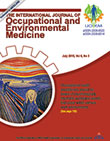فهرست مطالب

International Journal of Occupational and Environmental Medicine
Volume:6 Issue: 3, Jul 2015
- تاریخ انتشار: 1394/09/24
- تعداد عناوین: 8
-
-
Pages 129-143BackgroundQat (also known as Khat, Kat and Miraa) is a green-leaved plant (Catha edulis). It is a shrub indigenous to Yemen and certain parts of eastern Africa. Chewing the leaves, which have sympathomimetic and euphoric effects, has been documented in many countries and increased with worldwide migration. The effect of long-term chewing Qat on the oral cavity is unknown.ObjectiveA systematic review was performed to identify any associations between Qat chewing and the occurrence of potentially malignant and malignant oral disorders.MethodsMedline and the Web of Science were searched for articles published before May 2014 without limits with regard to publication date and language.ResultsFrom a total of 890 papers identified, 17 English papers reported potentially malignant or malignant oral disorders and Qat chewing. One additional paper in Arabic language was identified from reviewing the list of references of eligible papers. It was found that exposure to Qat may be associated with potentially malignant and malignant oral disorders, but methodological issues, such as inadequate study design, sample size, selection of study subjects, clinical evaluations of outcome and limited adjustment for confounders, limit the strength of the evidence base in this area.ConclusionThe association between Qat chewing and potentially malignant and malignant oral disorders remains debatable and requires further investigations.Keywords: Catha edulis, Oral disorders, Yemen, Euphoria, Neoplasms, Oral health
-
Pages 144-154BackgroundNorthern Ontario, Canada has a larger elder population, more resource-based employment, and limited access to physicians and specialists compared to southern Ontario. Given these important differences, it is possible that work disability rates will vary between the two Ontario jurisdictions.ObjectiveTo determine the association between time lost due to workplace injuries and illnesses occurring in northern vs southern Ontario and work disability duration from 2006 2011.MethodsThe study base included all lost-time claims approved by the Workplace Safety and Insurance Board in Ontario, Canada for workplace injury or illness compensation occurring between January 1, 2006 and December 31, 2011. All eligible participants had to be 18 years of age or older at the time of making the claim and participants were excluded if one of the three variables used to determine location (claimant home postal code, workplace geographical code, and WSIB firm location) were missing. Multivariable proportional hazards regression models were used to estimate hazard ratios and 95% confidence intervals adjusted for sex, age, occupation, part of body, and nature of injury relating Ontario geographical location to compensated time off work.ResultsA total of 156 453 lost-time claims were approved over the study period. Injured and ill workers from northern Ontario were 16% less likely to return to work than those from southern Ontario. Adjustment for potential confounding factors had no effect.ConclusionThe disability duration in northern Ontario is longer than that in southern Ontario. Future research should focus on assessing the relevant factors associated with this observation to identify opportunities for intervention.Keywords: Return to work, Ontario, Occupational injuries, Occupational diseases, Sick leave
-
Pages 155-168BackgroundPsychologically traumatic workplace events (known as critical incidents) occur within various work environments, with workgroups in certain industries vulnerable to multiple incidents. With the increasing prevalence of incidents in the USA, incident response is a growing practice area within occupational medicine, industrial psychology, occupational social work and other occupational health professions.ObjectiveTo analyze a measure of incident severity based on level of disruption to the workplace and explore whether incident severity varied among different industry settings or between workgroups experiencing multiple vs single traumatic incidents.MethodsAdministrative data mining was employed to examine practice data from a workplace trauma response unit in the USA. Bivariate analyses were conducted to test whether scores from an instrument measuring incident severity level varied among industry settings or between workgroups impacted by multiple vs isolated events.ResultsIncident severity level differed among various industry settings. Banks, retail stores and fast food restaurants accounted for the most severe incidents, while industrial and manufacturing sites reported less severe incidents. Workgroups experiencing multiple incidents reported more severe incidents than workgroups experiencing a single incident.ConclusionOccupational health practitioners should be alert to industry differences in several areas: pre-incident resiliency training, the content of business recovery plans, assessing worker characteristics, strategies to assist continuous operations and assisting workgroups impacted by multiple or severe incidents.Keywords: Workplace, Workplace violence, Occupational injuries, Psychology, industrial
-
Pages 169-176BackgroundTraditional Thai tobacco (Nicotiana abacus L.) is known as a non-Virginia type whose mature leaf contains three to four times more nicotine than that of a Virginia type. As such, the process of Thai traditional tobacco production may lead to adverse health effects such as green tobacco sickness (GTS).ObjectiveTo investigate the prevalence of GTS and risk factors related to GTS among Thai traditional tobacco farmers in Nan province, northern Thailand.Methods473 Thai traditional tobacco farmers from rural areas in Nan province were randomly selected and interviewed in person by means of questionnaires and environmental survey. Statistical analyses were used to identify potential risk factors for GTS.ResultsThe prevalence of GTS was 22.6% (95% CI 19.1% to 26.6%). Multivariate analysis showed various risk factors associated with GTS including gender of the farmer (ORadj 0.44, 95% CI 0.26 to 0.73), smoking (ORadj 4.36, 95% CI 1.41 to 13.47), skin rash (ORadj 0.36, 95% CI 0.19 to 0.68), wearing a wet suit (ORadj 1.91, 95% CI 1.12 to 3.23), process of curing tobacco leaves (ORadj 0.06, 95% CI 0.02 to 0.16), and watering tobacco plants (ORadj 0.42, 95% CI 0.25 to 0.72).ConclusionThe process of traditional Thai tobacco production can result in increased dermal exposure and can be considered a major risk factor for GTS. Body soaking during watering may further increase adverse health effects related to GTS.Keywords: Prevalence, Risk factors, Tobacco, Thailand, Agricultural worker's diseases
-
Pages 177-183Glutaraldehyde is commonly used in endoscopy labs to clean and disinfect instruments. It can cause direct irritation of the skin and the upper and lower airways. Health care workers are also at risk for the development of irritant-induced or sensitizer-induced occupational asthma when exposed to this chemical. Herein, we report on a patient who had frequent exposures to glutaraldehyde over one year while working in an endoscopy lab and developed chronic upper and lower respiratory tract symptoms. Multiple spirometric tests during her evaluation revealed variable results including restrictive pattern with a response to bronchodilators, obstructive pattern with a paradoxic bronchoconstrictive response to bronchodilators, and obstructive pattern with a partial response to bronchodilators. These results indicate that the distribution of inflammation and bronchial responsiveness can vary in a single patient with glutaraldehyde-induced occupational asthma. Therefore, the evaluation may be more difficult than might be expected in patients with occupational asthma, and some patients will need multiple pulmonary function tests to characterize their airway disease.Keywords: Glutaral, Asthma, occupational, Occupational exposure, Inhalational exposure, Health personnel
-
Pages 187-188


